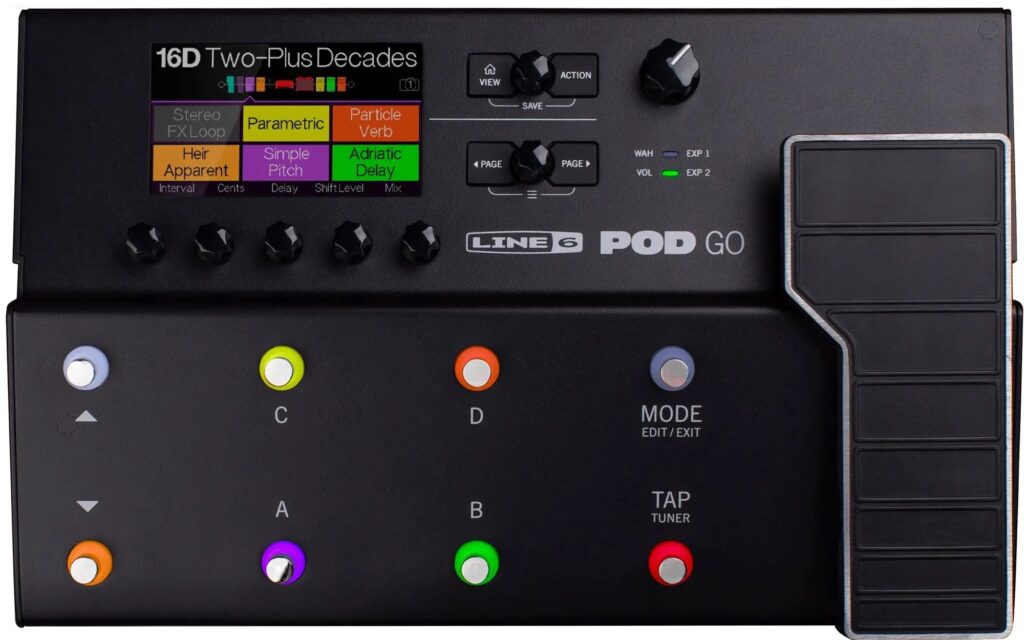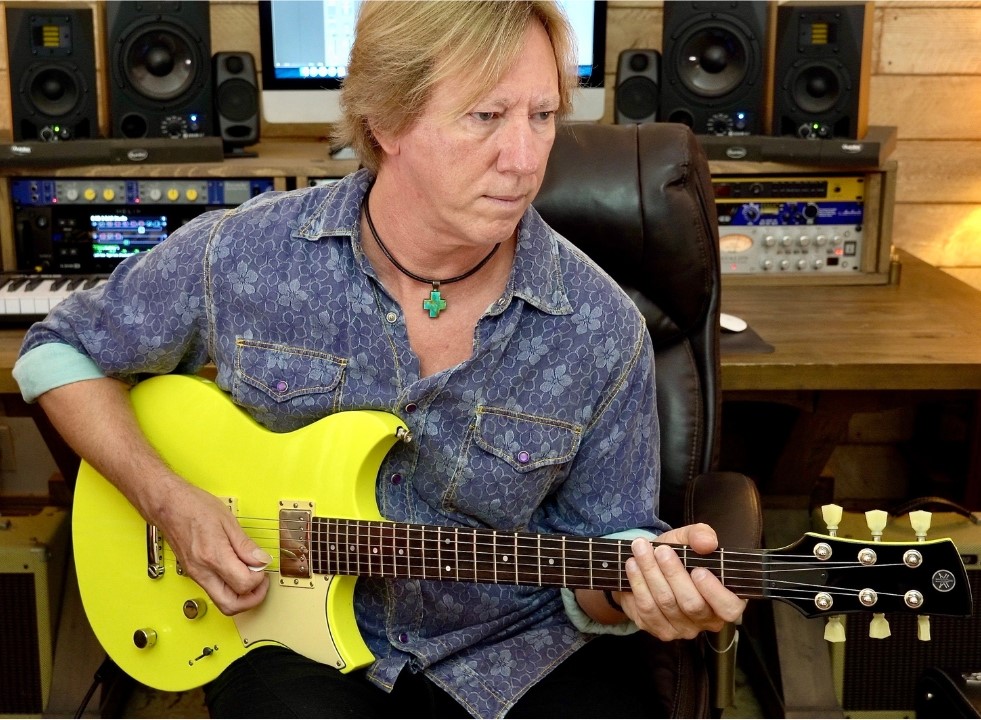A Guitarist’s Guide to Major and Minor Pentatonic Scales
Using a blend of the two often yields the best results.
In a previous blog posting, I described how to use minor pentatonic scales when playing guitar. In this posting, we’ll expand on that theme by taking a deep dive into the world of both major and minor pentatonic scales as they apply to guitar.
The first scale shape that most guitarists learn, in fact, is the five-note minor pentatonic scale, pattern 1; it’s certainly the one I show my students first. Pentatonic scale shapes have a dual functionality that’s easy to understand and apply. That’s because any of the five minor pentatonic scale shapes also function as the relative major pentatonic scale.
Let’s take a closer look at how this all works.
Relative Major and Minor
As an example, here’s pattern 1 of the B minor pentatonic scale:

This gives us the following five distinct tones:
Scale intervals: T – Mi3 – P4 – P5 – Mi7
Scale tones: B – D – E – F# – A
As you can see, there’s a tonic (T, or root note), a minor third (Mi3), a perfect fourth (P4), a perfect fifth (P5) and a minor 7th (Mi7). These are the tones that make up a minor seventh chord, with the addition of the perfect fourth.
If you start that scale on the second note (D) and call that our new tonic, you get the same five notes, but this time they form the D major pentatonic scale:

Here, the scale intervals and scale tones are as follows:
Scale intervals: T – Ma2 – Ma3 – P5 – Ma6
Scale tones: D – E – F# – A – B
Those five notes create a major triad (the root, major third and major fifth), along with a major second (ninth) and a major sixth (thirteenth).
As you can see, the same shape can function in two different musical worlds — major and minor. This means that learning one shape of the pentatonic scale actually gives you two scales for the price of one.
But what about a dominant seventh chord? This chord is made up of a major triad (root, major third and perfect fifth) plus a minor seventh. In effect, it acts as a hybrid major and minor chord. These colorful bluesy chords have a very specific sound that create harmonic tension, and they sound great on their own, either within a progression or as passing chords.
So, given that there is one shape that covers improvisations in both major and minor keys, how do we capitalize on that shape when we play over dominant seventh chords? To answer this question, first we need to explore …
Dominant Chord Progressions
Quite often you’ll need to improvise over a dominant sounding chord progression. Which of the two pentatonic scales would we use over this kind of progression? The answer is, you can use both; as we’ve seen, B minor pentatonic and D major pentatonic contain the same tones. But you may be surprised to learn that you can also use the B minor pentatonic and B major pentatonic scales.
To understand this, simply move pattern 1 of the B minor pentatonic scale to G# (four frets lower), and you’ll get the B major pentatonic scale:

This means you can use the same scale shape in two fretboard locations to create completely different licks and lines for your solos … and what makes this approach even more powerful is that the same lick in one shape can be used again in the other location (shape) for a totally different effect. I like to think of this as getting extra mileage (and extra value) out of your scale shapes.
Next, take a look at these fretboard diagrams of the B minor pentatonic scale shape and the G# minor pentatonic (B major pentatonic) scale shape:


You’ll find that playing a B major pentatonic scale over a dominant chord sounds more settled and consonant, whereas the B minor pentatonic over a dominant chord will have a bluesier characteristic. You’ll probably want to bend the minor third of the minor scale a little to at least imply the major third found in a B7 dominant chord.
Mixing Minor and Major Pentatonic Scales
You may already be used to playing a minor pentatonic scale over dominant blues progressions, but you may not have ventured yet into mixing major and minor for extra flavors and options.
Ready to get started? Follow these four simple steps:
1. Play a two- or four-bar phrase in B minor pentatonic. Then play the same lick in B major pentatonic (simply move the idea to the same shape that starts at the fourth fret, G# minor).
2. Expand upon this idea by adding another shape of the minor pentatonic patterns, such as:

3. Try playing an ascending lick using the minor pentatonic scale, followed by a descending phrase using the major pentatonic, then reverse the order.
4. Learn more shapes of pentatonic scales and try swapping between the two new shapes.
The Video
For this video, I created the following dominant chord progression to demonstrate mixing the B minor and B major pentatonic scales when improvising:
II: B5 A5//B I B/A E/B A5/B I B5 A5/B I G#mi7 E5 :II
I then overlaid a sixteen-bar solo that mixes several patterns of the minor and major pentatonic scale. In the first eight measures, I play a similar phrase from both minor and major (four measures on each from patterns 1 and 2). I then continue to alternate between minor and major for the next eight measures. After that, I’m moving through additional pentatonic shapes to find new ideas.
I also added some tasty chromatic ideas, achieved by adding the flat 5 from the blues scale. (The blues scale is the minor pentatonic scale with an added flat five.)

As I solo, I’ve indicated on the video which scale I’m using, plus here’s a link where you can find the tab and notation as well as the effects preset I used; this file can be downloaded into a Line 6 POD ® Go effects processor if you have one. (See below for more information.)
Feel free to jam along with the audio file below.
The Guitar

In this video, I’m playing a Yamaha Revstar Standard RSS20, which now comes in three new colors: Vintage White, Fired Red and Sonic Blue. The guitar I’m playing is a Sonic Blue model, which has stunning cream-colored cafe racer stripes on the body as well as on the scratch plate, binding and pickup mounts.
The acoustically tuned mahogany body of this extraordinary instrument enhances string sustain and resonance, and the neck-through body transfers that energy along the entire neck and headstock. The two silver Alnico V humbucking pickups sound detailed, fat and warm, making the RSS20 eminently suitable for any style of music. A five-way pickup selector switch allows you to choose either or both of the two pickups; additional positions reverse the pickup polarity to create those desirable “out-of-phase” tones found on guitars with three single-coil pickups.
The tone control also doubles as a pull pot. Engaging the pull function employs a passive focus feature, which essentially adds a mid-boost reminiscent of over-wound pickups (i.e., pickups with a higher output). Having ten onboard sounds available makes the RSS20 one of the most versatile guitars you’ll find anywhere.
The Processor/Modeler

I also opted to pair the Revstar RSS20 with the powerhouse POD Go modeler from Line 6. This effects processor and amp modeler creates amazing guitar tones in an ultra-portable plug-and-play interface and pedalboard.
The POD Go allows you to create custom signal chains, patches and entire set lists for studio recording and stage performance. It packs a serious tonal punch without breaking the bank … and travels easily in a backpack to the gig or jam session.
The Wrap-Up
The five-note pentatonic scale is derived from the seven-note major scale. And just like its larger parent scale, it can be used over major, minor and dominant seventh chords.
When you learn one pentatonic scale shape, its application can be expanded greatly by simply moving it to other fretboard locations. Add additional shapes and you have an ever-expanding set of improvisational options. By shifting between shapes and fretboard locations you can create a wide variety of melodic phrases that outline the chord tones or add tension with bluesier superimpositions.
To learn more about pentatonic scale usage and phrasing, please check out my three “Pentatonic Protocols” courses at https://www.tradinglicks.pro.















